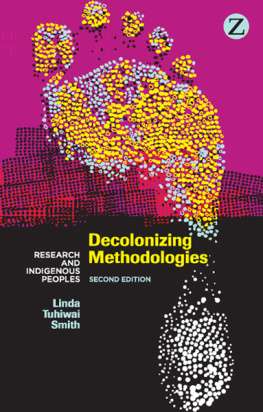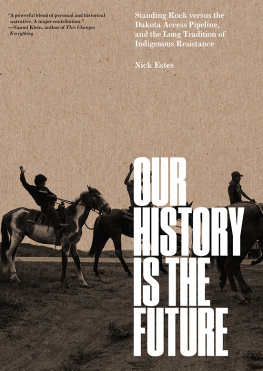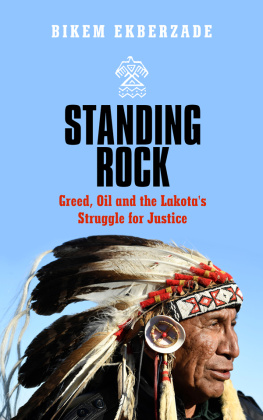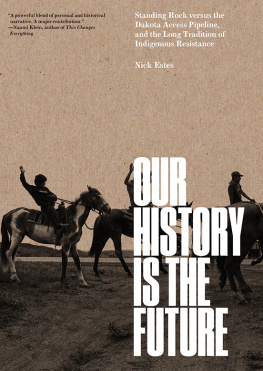Table of Contents
Pagebreaks of the print version
Guide

For Water Protectors Everywhere
M NI W ICONI!
Authors Note
Books are born for many reasons. This one emerged as a result of many years of research and activism, which for me has always focused on environmentalism, Native sovereignty, and their intersection. If what the preeminent Indian law scholar Felix Cohen said was true, that Indians are the United States miners canary that signals the poison gas of the political atmosphere, to extend the metaphor, then in the larger world dominated by the fossil fuel industry all humans have become the miners canary. On a planet with a rapidly changing climate and undergoing what many scientists believe is the Earths sixth mass extinction, the future of humanity is looking about as bright as it did for American Indians in 1953 when Cohen wrote those words railing against federal Indian policy (known as termination, which was every bit as menacing as it sounded). From an American Indian perspective, were all on the reservation now.
In the past few decades it has become crystal clear that, as the people, our common enemy is the entrenched corporate power of Big Oil and other toxic industries that buy political influence to protect their own corrupt interests in collusion with government, all in the name of democracy. This has come at the expense of countless marginalized people worldwide. In the US, that has always meant Indigenous people, other people of color, and those having low incomes. The overall goal of this book is to highlight the importance of building alliances across social and racial divides. To do this requires an honest interrogation of the history of the relationships between the environmental movement and Indian country.
In my years of research and writing on American Indian environmental justice (EJ), I have observed two locations where those conversations predominantly occur: in academia and in activist spaces. By activist spaces, I am referring to points of contact between activist groups (such as spontaneous actions or movements, coalitions, and nonprofits), governmental agencies in charge of implementing environmental policies, and business interests those policies may or may not regulate in the process of development. Academics in environmental studies, Native studies, and other disciplines educate students on the histories and principles of EJ in different EJ communities, but they face a dearth of literature from which to teach on the topic relative to Indigenous peoples. A similar lack of knowledge exists within governmental and nongovernmental institutions and businesses. People in these organizations might have access to lawyers trained in federal Indian law, but law is only one aspect of the EJ world, especially when it comes to Indian country, not to mention the fact that federal Indian law is a creation of colonial forces and not particularly designed to deliver justice to Indian people. Lawyers with expertise in federal Indian law often are also neither versed in environmental justice history or principles nor are aware of other critical work by historians and other academics that inform EJ praxis (that is, the way EJ is imagined and implemented).
American Indian activists doing EJ work, however, tend to be quite knowledgeable about the issues they are working for and the histories that inform those issues. As a result, they inevitably end up having to educate, with no additional financial compensation, the various groups they interact with, people with whom they often have contentious relationships to begin with. This points to an in-between space in Indigenous environmental justice organizing, where there is a need for education that helps build the foundation for productive relationships. Thus, a primary goal of this book is to help fill that gap by providing a broad overview about what environmental injustice is for American Indians, describing what justice looks like, and proposing avenues to get there. The only book of its kind to date, my hope is that it will be used not only in classrooms but also by every organization, institution, and individual that engages with Indigenous peoples on the protection of the environment and their rights within it.
NOTE ON TERMINOLOGY
There are numerous terms used to describe and define American Indian people. Some are more accurate or appropriate than others, depending on context. Some are a matter of personal preference, while others are more legal in nature. As a general rule of thumb, the most appropriate terms are specific Native nation names, such as Lakota, Din (aka Navajo), or Anishinaabe. But when referring to American Indians collectively, the older terms American Indians, Indians, and tribes are terms used in federal legal parlance, and tribal nations and individuals often still use these terms. Native American is more contemporary and also used in legal contexts, but many Native people prefer simply Native in addition to their specific tribal names. Native people often also prefer the term nation to tribe, since tribe can imply cultural inferiority, while nation invokes Indians historical, preinvasion self-determination and governing systems. The terms Indigenous and fourth world signal originality to place and also provide context for a more global category of people who share similar struggles against states. Accounting for these complexities, the terms are used interchangeably throughout the text. When discussing specific American states, except where naming specific states (such as Washington State), state (lowercase s) is used to distinguish the individual state from State (capital S) meaning the US nation-state.
INTRODUCTION
The Standing Rock Saga
We are unapologetically Indigenous, we embody resistance, everything we do from eating rubber bullets for breakfast to holding our frontline has been done in a manner that is nothing but spiritual.
RED WARRIOR CAMP COMMUNIQUE, DECEMBER 15, 2016
As things often do in Indian country, it began with a story, this one a prophecy. Ancestors of todays Lakota, the people of Oceti Sakowin, had for generations warned about a black snake that would slither across the land, bringing destruction to the Earth and her people. The day representatives for Energy Transfer Partners entered the council chambers of the Standing Rock Sioux Tribe on September 30, 2014, to present plans for the Dakota Access Pipeline (DAPL), it perhaps came as no surprise to the tribal council that another pipeline was threatening Lakota lands. Other Lakota bands, Plains tribes, and white ranchers and farmers were, after all, already fighting the Keystone XL Pipeline. But nobody that day could have predicted the debacle the DAPL would turn intothe extremes to which Energy Transfer Partners (ETP) would go to put down tribal opposition to the project, beginning with CEO Kelsey Warrens lie that the tribe had not registered their dissent to the project early enough, and that if they had, the pipeline could have been rerouted. Or the human rights abuses by ETPs private security firms and militarized state police that would bring United Nations observers to the protest camps. Or the level of support the tribe would receive for a cause millions of people around the world found to be righteous. Then again, maybe they could have.
The startling truth is that there are 2.4 million miles of black snakes in the United States. These pipelines convey more crude oil, gasoline, home heating oil, and natural gas than any other country in the world., claiming they are generally considered safer than truck or rail transport. Yet hundreds of pipeline leaks and ruptures occur each year, with consequences that range from relatively benign to catastrophic. And with the pipeline infrastructure aging, critics warn about increasing risk of accidents.












